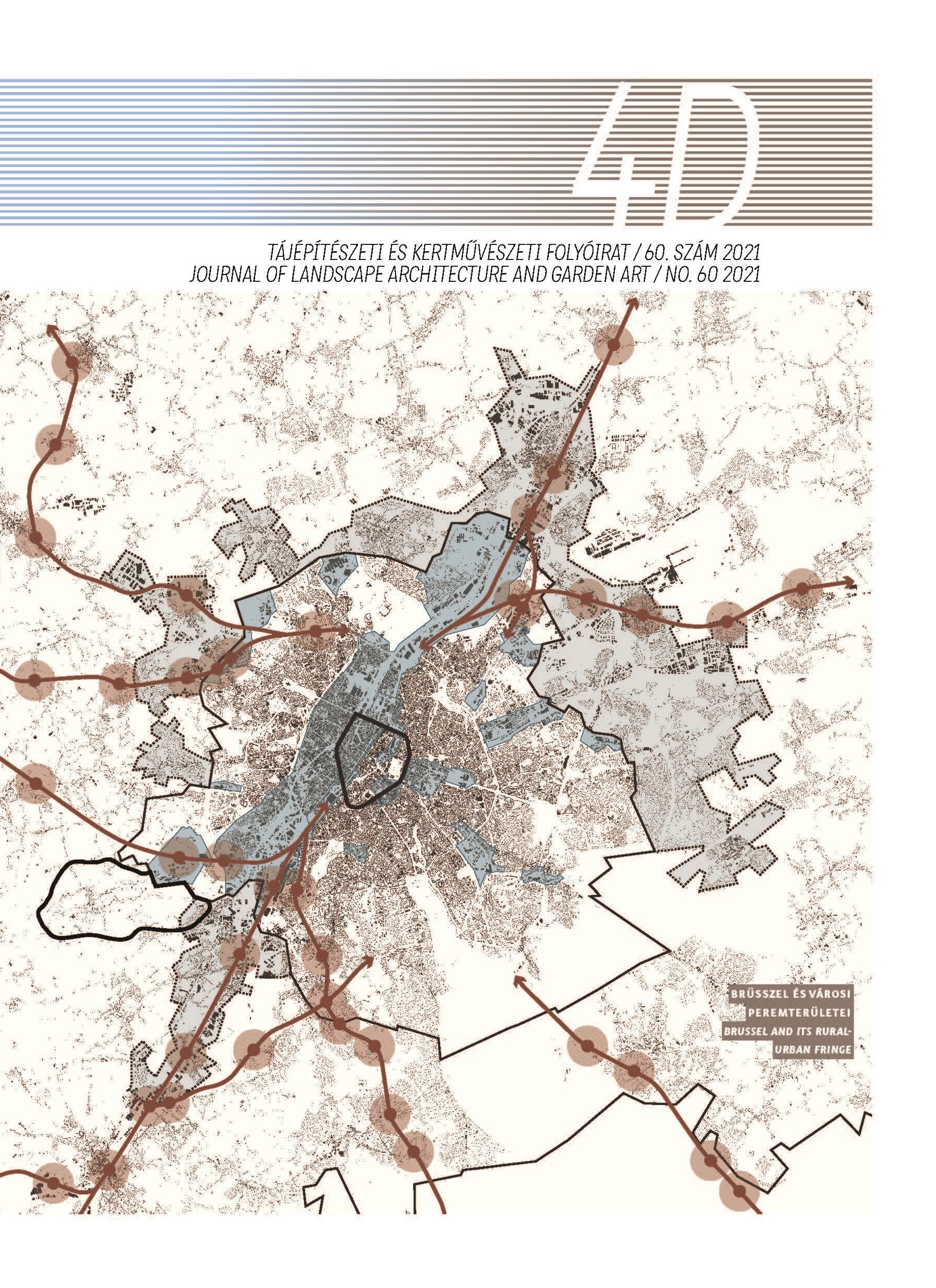A városi peremterületek klímaadaptációs lehetőségei
Tervezési gyakorlaton alapuló kutatás a klímaváltozás hatásainak feltárására Brüsszel térségében
DOI:
https://doi.org/10.36249/60.1Kulcsszavak:
Klimaadaptáció, Vidéki-városi peremterület, Árvizek, Aszályok, Talajerózió, Városi hősziget (UHI)Absztrakt
A globális felmelegedés következtében a városoknak alkalmazkodniuk kell a változó éghajlathoz, beleértve a súlyosbodó árvizeket és a megnövekedett hőstresszt. A település- és tájtervezők klímabiztos városokat alakítanak ki olyan zöld terek létrehozásával, melyek képesek mérsékelni, kiegyenlíteni a klimatikus hatásokat. A városi peremterületeken (VPT) a zöldfelületek, és különösen a termőföldek, gyors változáson mennek keresztül: beépített területté sorolják át őket, kisebb magántulajdonú parcellákat alakítanak ki (például kerteket, lovardák legelőit). A tanulmányunkban azt vizsgáltuk, hogy ezek a városi peremterületeken bekövetkezett fejlesztések hogyan befolyásolják az árvizeket és a hőstressz hatását a környező városi területeken. Ezen túlmenően feltártuk a VPT zöldfelületeiben rejlő lehetőségeket a klímahatások enyhítésére helyi és nagyvárosi szinten egyaránt. A kutatásunkat egy esettanulmány keretén belül végeztük a brüsszeli városi peremterületeken, azon belül pedig a Vogelzang vízgyűjtő területén. A tanulmány térképek, metszetek és egyéb grafikai eszközök segítségével feltárta Brüsszel éghajlathoz alkalmazkodásának összetettségét, és rámutatott a városközpont és a dél-nyugati VPT közötti kapcsolatokra. Földrajzi elhelyezkedéséből adódóan a Vogelzang vízgyűjtő területe klímastratégiai jelentőséggel bír az árvizek, aszályok és a hőstressz kezelésében, a városi területeken belül is. Munkánk során azt is vizsgáltuk, hogyan lehet a Vogelzang vízgyűjtő területe „éghajlathoz alkalmazkodó”. Az esettanulmány egy olyan koncepcióra épül, amely új élelmiszerlánc-ellátásra tesz javaslatot. Cikkünk áttekintést ad a brüsszeli adottságokról, ugyanakkor visszacsatolást nyújt a VPT fenntartható tervezéséhez kapcsolódó szakmai vitához. Először is rávilágít arra, hogy a VPT zöldfelületei hozzájárulhatnak az éghajlati alkalmazkodáshoz, lokális és nagyvárosi szinten is. Ezért a városok klímaadaptív tervezésének kihívásai túllépnek a város határain, és a tervezőknek be kell vonniuk a városi peremterületeket is a helyi éghajlati alkalmazkodás jövőképébe. Bemutattuk továbbá, hogy a VPT mezőgazdasági területei milyen nagy potenciállal rendelkeznek a terület fenntartható fejlesztését illetően, beleértve az klímaváltozás hatásait kiegyenlítő felületek létrehozását.
Hivatkozások
Pielke, R. – Prins, G. – Rayner, S. ̶̶ Sarewitz, D. (2007): Lifting the taboo on adaptation. Nature, 445(February), 8–9.
Revi, A. – Satterthwaite, D.E. – Aragón-Durand, F. etal. (2014): Urban Areas. In Climate Change 2014: Impacts, Adaptation, and Vulnerability : Part A: Global and Sectoral Aspects : Working Group II Contribution to the IPCC Fifth Assessment Report, Cambridge University Press: Cambridge, p. 535–612. DOI: https://doi.org/10.1017/CBO9781107415379.013
Kazmierczak, A. – Carter, J. (2010): Adaptation to climate change using green and blue infrastructure : A database of case studies. URL: https://orca.cardiff.ac.uk/id/eprint/64906/1/ [2020.12.01]
Foster, J. – Lowe, A. – Winkelman, S. (2011): The value of green infrastructure for urban climate adaptation. Center for Clean Air Policy, 750 (2), URL: https://savetherain.us/ [2020.12.01]
Tjallingii, S.P. (1996): Ecological Conditions : strategies and structures in environmental planning. [PhD thesis], TU Delft, Delft, The Netherlands
Downton, P.F. (2009): Ecopolis: architecture and cities for a changing climate. Springer Dordrecht: the Netherlands, Series Title: Future City DOI: https://doi.org/10.1007/978-1-4020-8496-6
Scott, A. – Carter, C. – Reed, M.R. et al. (2013): Disintegrated development at the rural–urban fringe: Reconnecting spatial planning theory and practice. Progress in Planning, 83, 1–52. DOI: https://doi.org/10.1016/j.progress.2012.09.001
Houston, P. (2005): Re-valuing the Fringe : Some Findings on the Value of Agricultural Production in Australia’s Peri-Urban Regions. Geographical Research, 43 (2), 209–223. DOI: https://doi.org/10.1111/j.1745-5871.2005.00314.x
Kerselaers, E. (2012): Participatory development of a land value assessment tool for agriculture to support rural planning in Flanders. [PhD thesis], Ghent University, Applied Biological Sciences: Ghent.
Dewaelheyns, V. – Rogge, E. – Gulinck, H. (2014): Putting domestic gardens on the agenda using empirical spatial data: The case of Flanders. Applied Geography, 50, 132-143. DOI: https://doi.org/10.1016/j.apgeog.2014.02.011
Bomans, K. – Dewaelheyns, V. – Gulinck, H. (2011): Pasture for horses: An underestimated land use class in an urbanized and multifunctional area. International Journal for Sustainable Development and Planning, 6(2), 195-211. DOI: https://doi.org/10.2495/SDP-V6-N2-195-211
Zasada, I. – Berges, R. – Hilgendorf, J. – Piorr, A. (2013): Horsekeeping and the periurban development in the Berling Metropolitan Region. Journal of Land Use Science, 8(2),199-214.
Verhoeve, A. – Dewaelheyns, V. – Kerselaers, E. et al. (2005): Virtual farmland : Grasping the occupation of agricultural land by non-agricultural land uses. Land Use Policy, 42, 547-556. DOI: https://doi.org/10.1016/j.landusepol.2014.09.008
Stokman, A. – Rabe, S. – Ruff, S. (2008): Beijing’s New Urban Countryside – Designing with Complexity and Strategic Landscape Planning. Journal of Landscape Architecture, 3(2), 30–45.
Weller, R. (2008): Planning by Design Landscape Architectural Scenarios for a Rapidly Growing City. Journal of Landscape Architecture 3(2), 18–29.
Shazi, S. – Frederickson, M. – Larry, M. (2013): Minimizing Urban Sprawl through Open Space Design Strategies: The Case of Tucson, Arizon. The International Journal of Architectonic, Spatial, and Environmental Design, 6(2), 107–124.
Farhat, G. (2008): The urban as infrastructural landscape. Journal of Landscape Architecture, 3(1), 56–67.
Boeckx, L. – Franken, T. – Deschamps, M. et al. (2011): Wasgebeurtenissen 11-16. november 2010. Beschrijving hydrologische gebeurtenissen 2011, a report by Waterbouwkundig Laboratorium (WatLab), Antwerp (Belgium) URL: https://docplayer.nl/25814409-Wasgebeurtenissen-november-2010 [2020.12.01.]
Van Weverberg, K. – De Ridder, K. – Van Rompaey, A. (2008): Modeling the Contribution of the Brussels Heat Island to a Long Temperature Time Series. Journal of Applied Meteorology and Climatology, 47(4), 976–990.
Brouwers, J. – Peeters, B. – Van Steertegem, M. et al. (2015): MIRA Klimaatrapport 2015, Over waargenomen en toekomstige klimaatveranderingen 2015, the Flemish Environmental Agency (VMM): Aalst (Belgium)
Stewart, I.D. (2007): Landscape representation and the urban-rural dichotomy in empirical urban heat island literature 1950–2006. Acta Climatologica et Chorologica, 40–41, 111–121.
Hamdi R. – Van De Vyver H. – De Troch R. – Termonia P. (2013): Assessment of three dynamical urban climate downscaling methods: Brussels’s future urban heat island under an A1B emission scenario. International Journal of Climatology, 34(4), 978–999. DOI: https://doi.org/10.1002/joc.3734
Denis Dujardin (2014): Inter-gewestelijk richtplan voor Neerpede-Vlezenbeek-Sint Anna Pede, Rapport deel 3 - Actieplannen. Commissioned by Leefmlieu Brussel and VLM, Brussels (Belgium) URL: https://document.environnement.brussels [2020.12.01.]
Wiskerke, J. (2009) On Places Lost and Places Regained: Reflections on the Alternative Food Geography and Sustainable Regional Development. International Planning Studies, 14(4), 369–387. DOI: https://doi.org/10.1080/13563471003642803
Charrudas, P. – Deligne, C. (2007): La ville au milieu des marais: dynamiques entre économie urbaine et zones humides dans la région de Bruxelles, XII e - XVI e siècle. Aestuaria, (9), 65–82.
Vanempten, E. (2014): Fringe urbanism. [PhD thesis], KU Leuven, Engineering Department, Leuven,
Condon, P.M. – Mullinix, K. – Fallick, A. – Harcourt, M. (2010): Agriculture on the edge: strategies to abate urban encroachment onto agricultural lands by promoting viable humanscale agriculture as an integral element of urbanization. International Journal of Agricultural Sustainability, 8(1-2), 104–115. DOI: https://doi.org/10.3763/ijas.2009.0465
R. Mujeriego – J. Compte – T. Cazurra – M. Gullo (2008): The water reclamation and reuse project of El Prat de Llobregat, Barcelona, Spain. Water Science and Technology, 57(4), 567–574. DOI: https://doi.org/10.2166/wst.2008.177
Letöltések
Megjelent
Folyóirat szám
Rovat
License
Copyright (c) 2021 JEROEN DE WAEGEMAEKER, Van Acker Maarten, Eva Kerselaers, ELKE ROGGE

This work is licensed under a Creative Commons Attribution-NonCommercial-NoDerivatives 4.0 International License.
A folyóirat Open Access (Gold). Cikkeire a Creative Commons 4.0 standard licenc alábbi típusa vonatkozik: CC-BY-NC-ND-4.0. Ennek értelmében a mű szabadon másolható, terjeszthető, bemutatható és előadható, azonban nem használható fel kereskedelmi célokra (NC), továbbá nem módosítható és nem készíthető belőle átdolgozás, származékos mű (ND). A licenc alapján a szerző vagy a jogosult által meghatározott módon fel kell tüntetni a szerző nevét és a szerzői mű címét (BY).









 intézetigazgató: Dr. Fekete Albert
intézetigazgató: Dr. Fekete Albert

